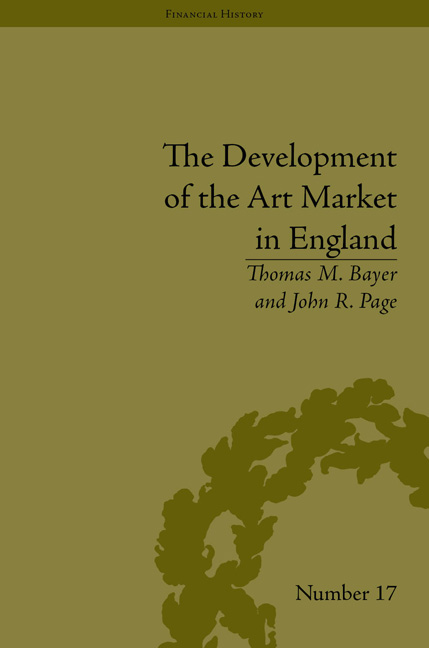Book contents
- Frontmatter
- CONTENTS
- Acknowledgements
- List of Figures and Tables
- Dedication
- Introduction
- 1 The Early Stages: From the Netherlands to Great Britain
- 2 The Commoditization of Theories of Art
- 3 The Painter as Homo Economicus
- 4 Critics and Auctions
- 5 The Evolution of Picture-Dealing
- 6 The Victorian Era
- 7 ‘Working the Oracle’: The Tools of the Trade
- 8 The Formation of a Nexus: A Story of Christie's
- 9 Commoditization and the Artist as Producer: Product Differentiation and the Domestication of Pictures
- 10 The End of the ‘Golden Age’
- 11 Postscript: A Perpetual Innovative Whirl
- Notes
- Works Cited
- Index
5 - The Evolution of Picture-Dealing
- Frontmatter
- CONTENTS
- Acknowledgements
- List of Figures and Tables
- Dedication
- Introduction
- 1 The Early Stages: From the Netherlands to Great Britain
- 2 The Commoditization of Theories of Art
- 3 The Painter as Homo Economicus
- 4 Critics and Auctions
- 5 The Evolution of Picture-Dealing
- 6 The Victorian Era
- 7 ‘Working the Oracle’: The Tools of the Trade
- 8 The Formation of a Nexus: A Story of Christie's
- 9 Commoditization and the Artist as Producer: Product Differentiation and the Domestication of Pictures
- 10 The End of the ‘Golden Age’
- 11 Postscript: A Perpetual Innovative Whirl
- Notes
- Works Cited
- Index
Summary
Pears estimates that up to 40 per cent of recorded picture sales between 1711 and 1760 were organized by dealers to sell inventory. Their impact on the art economy is further corroborated by the earlier described frequently critical, if not outright hostile, comments made by native painters about the picture trade. Research into dealers’ role in the growth of the arts environment during the eighteenth century is still in its infancy and may well remain fragmentary due to the paucity of data. Nonetheless, the available information on dealer-organized sales suggests that these events may have affected noticeable fluctuations in the art market in general. The decrease in sales during the 1720s and 1730s, for example, coincided with a relatively low level of dealer activity, while the import boom in paintings of the early 1740s occurred amidst an increase in trade presence. Furthermore, inventory analyses show that the majority of dealers’ business consisted of sales of inexpensive original pictures or copies made by native artists of original works. Auctions data show that the average price of paintings sold during the first half of the eighteenth-century was around £15 with a median of £7.3. Pears determined that out of approximately 25,000 recorded transactions, only 545 fetched above £40. While most of the cheaper works often had impressive sounding attributions, their low prices indicate that most of them were copies or of uncertain authorship.
- Type
- Chapter
- Information
- The Development of the Art Market in EnglandMoney as Muse, 1730–1900, pp. 81 - 98Publisher: Pickering & ChattoFirst published in: 2014



